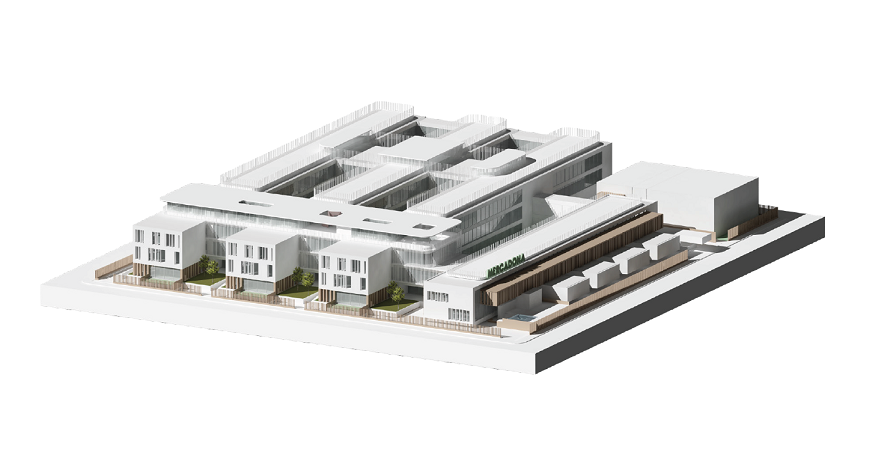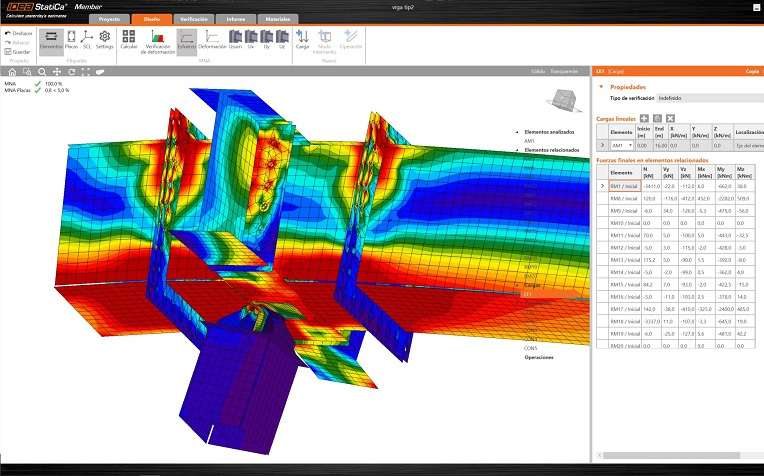Mercadona Offices in Albalat
About the Project
There will be around 150 suppliers and some 600 people collaborating on the construction of its new sustainable headquarters. The three buildings and underground car park will accommodate around 1,000 employees, and the €80 million investment will also seek to optimize the immediate surrounding area. Mercadona partnered with Construcciones Torrentinas Casol S.L. and ERRE Arquitectura for this project.
The project is made up of three independent parallel blocks with an approximate area of 35,000 m2. Each block boasts reinforced concrete beam spans of 16 meters.
The blocks are organized over three floors with a common underground parking area. They are connected by the car park across their entire below-ground level and also by two walkways at the above-ground level.
The vertical connection elements are located where the blocks intersect with the walkways, at which points the reinforced concrete curves appear. A level with a very different character is located above one of the cross-connection walkways, which connects the two concrete cores and two columns of each of the three blocks. For this reason, a steel structure was proposed.

Испания
Engineering Challenges
The key challenge of this project was its dimensions.
The 16-meter span of the block had to rise up to the top of the building, and another structure had to be built around it that didn’t compromise the rest of the structure.
The metal roof rests on 12 points (four for each block) and spans between supports at 13-16 meters in length, with a flight on each of its long sides (approximately six meters in length) resolved with variable-depth beams connected to large-shaped tubular profiles. These profiles absorb the torsions generated by the large overhangs. The supports are solved mostly as joints with displacements allowed on one or both axes. This singularly made it necessary to calculate a box profile to obtain the local defections in supports and the embedment of each cantilever beam.
The length of the roof structure also made it necessary to consider thermal expansions, so it was decided that several of its bearings should allow sliding to avoid structural joints. As the cantilever on the inside of the determined the design next to the right spans, a symmetrical cantilever was chosen. This allows the reduction of the span in one of the two orthogonal directions, taking advantage of the linear dimensions of the construction.
The structure has been designed using a mainframe supported at 12 points (six on the columns and six on the concrete chords), with two longitudinal beams connecting them.
The proximity of the columns to the facade generated the need for large cantilevers and, therefore, required a light structure capable of bridging spans between supports as well as supporting a cantilever on one of its facades. These beams are joined at six points by transversal beams (one for every two support points), and a subsection of beams of equal dimensions were added to compensate for the torsion generated by the cantilevers.
The two cantilevers of 5.8 meters will be born from this structure with profiles of the same depth, but that gradually decreases toward the edge, helping to reduce the structure’s weight. The torsion they generate in the main beams determines their geometry, and the positions of the longitudinal beams are therefore shaped profiles in 600 to 700 millimeters in depth.
All 12 connections were under a high level of stress, so they were adjusted to reduce the shared forces and focus those forces onto just two points.
IDEA StatiCa was used for the central part of the structure to analyze bearings in different cases and to calculate the deformations of each beam with the cantilever and steel pillars. The team was also able to visualize the stresses of the global beam as well as the local deformations of the plates of the shaped profile.

Испания
Solutions and Results
ERRE Arquitectura leveraged the orientation of the building and natural lighting of the surrounding areas to ensure employees could enjoy comfortable, naturally lit spaces while also ensuring lower power consumption. The three large courtyards also allow light to seep into the underground parking facilities, making them more pleasant.
The exterior of the buildings will be surrounded by green leisure areas that encourage the natural circulation of air, and the garden courtyards will absorb pollution while generating oxygen, improving the comfort of all employees. Harvested rainwater will be used to irrigate these spaces.
The interior design of the offices will comprise interconnected open spaces and simple interiors that use solar energy to encourage productivity and creativity.
Completion of this project is expected in 2023.
About ERRE arquitectura
ERRE is an architectural agency based in Valencia, Spain. Its large team of more than 40 seasoned professionals has been working on the development of residential, educational, sports, and public projects for over 20 years.
The ERRE team approaches architecture with passion and respect and seeks to give a functional solution to each of its designs to improve the life of the people who enjoy it. They have their department of structural design that allows them to improve the design process of projects as well as communication within their team.
Recent projects have included transforming the old Port America’s Cup base into an office and education center, the construction of the largest basketball facilities in Europe (with nine indoor and four outdoor courts), and a private hangar at Valencia airport. And with the building of the Mercadona offices well underway, the team can add another spectacular architectural success to their portfolio.
ERRE arquitectura was a finalist of IDEA StatiCa Excellence Awards 2021 with the projects of Mercadona Offices in Albalat.

Испания












